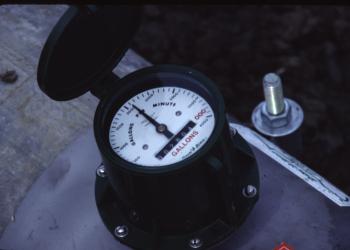University of California
Maintenance of Microirrigation Systems
Flow meters
Using flow meters to monitor for clogging
A flow meter installed at the head of a microirrigation system or small flow meters placed at the head of selected lateral lines can help you detect clogging.

Saddle-mount propeller meter installed at the head of a drip system. Note the instantaneous (gpm) and totalizing (gal) registers. Photo: L. Schwankl.
Make sure that the pipe in which you install the flow meter is installed is flowing full and that there is not excessive turbulence in the pipe. A flow meter installed close to a valve, elbow, or tee may not provide accurate information. If the meter has an instantaneous (e.g. gpm or cfs) indicator, an excessive fluctuation of the indicator needle is an sign of excessive turbulence in the meter. Always install flowmeters in accordance with the manufacturer's recommendations and local regulations.
To detect clogging, make periodic (e.g. daily, weekly, monthly) check of the flow rate in the system. A decrease in flow rate over time may indicate clogging may be occurring. Of course, the microirrigation system must be operating at the same pressure when both flow rates are determined if you want accurate, useful data. If you allow the operating pressure to vary, the flow rates will be valid but are difficult to compare from one period to another.

Small flow meter in a drip lateral line to monitor for clogging and determine the application rate. Photo: L. Schwankl.
How many small flow meters should should you use? One meter for every 5 acres is a good compromise between meter cost, resource commitment to read the meter, and quality of information.
Most small flow meters have only a totalizing register so you will need to keep track of the system operating time between meter readings. As with the large flow meter, operating pressure needs to stay constant for accurate comparisons over time.
Return to Evaluation of microsprinkler systems.
